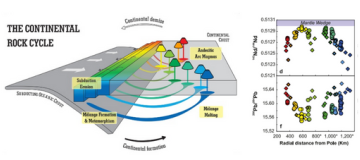
Continental formation and demise: perspectives from the Trans Mexican Volcanic Belt
Speaker: Dr. Mattia Parolari (Universidad Nacional Autónoma de México - Institute of Geology) - Giovedì 12 Gennaio - ore 16,30 | Aula Arduino
12.01.2023
At convergent margins, continents are unceasingly constructed and destroyed by arc magmatism and subduction, respectively. Interestingly, these opposing processes are intimately linked together. On one side, it has been widely accepted that arc magmatism is triggered by the interaction between subducted debris and the mantle wedge, and that at least some part of these materials is efficiently reincorporated in arc magmas; on the other, subaerial and tectonic erosion continuously supply subduction zones with additional continental materials, previously produced by arc magmatism. However, the extent and timing of this mass exchange between the continental crust and Earth’s mantle is still matter of a long-standing debate.
The Trans Mexican Volcanic Belt (TMVB) is a very complex continental arc but, however, represents a perfect natural laboratory to explore these questions about continents formation and destruction. The TMVB mainly generates high Mg# andesites and dacites with compositions that are almost identical to the bulk continental crust. Importantly, while these magmas show no or very little evidence of interaction with the upper plate, their chemical and mineralogical composition suggest instead a deep mantle origin. Thus, TMVB is suitable to investigate the potential interactions between subducted materials and the mantle wedge. Both the isotopic composition and trace elements abundances of these high-Mg lavas are strongly governed by the different subducted compositions. Moreover, the volumes of reworked materials are significantly higher than previously recognized and, thus, suggest a reassessment of the role of subducted materials in other arc settings. Our findings show that at this convergent margin a considerable part of the subducted materials is not lost to the deep mantle but is efficiently reworked by the main TMVB stratovolcanoes.





